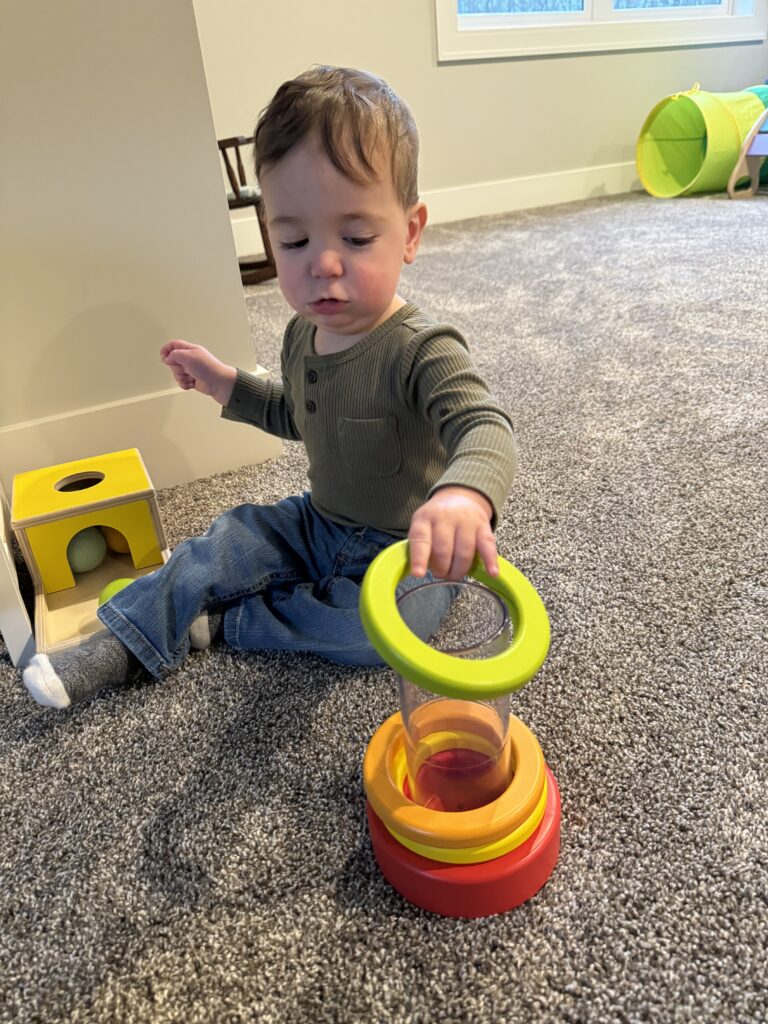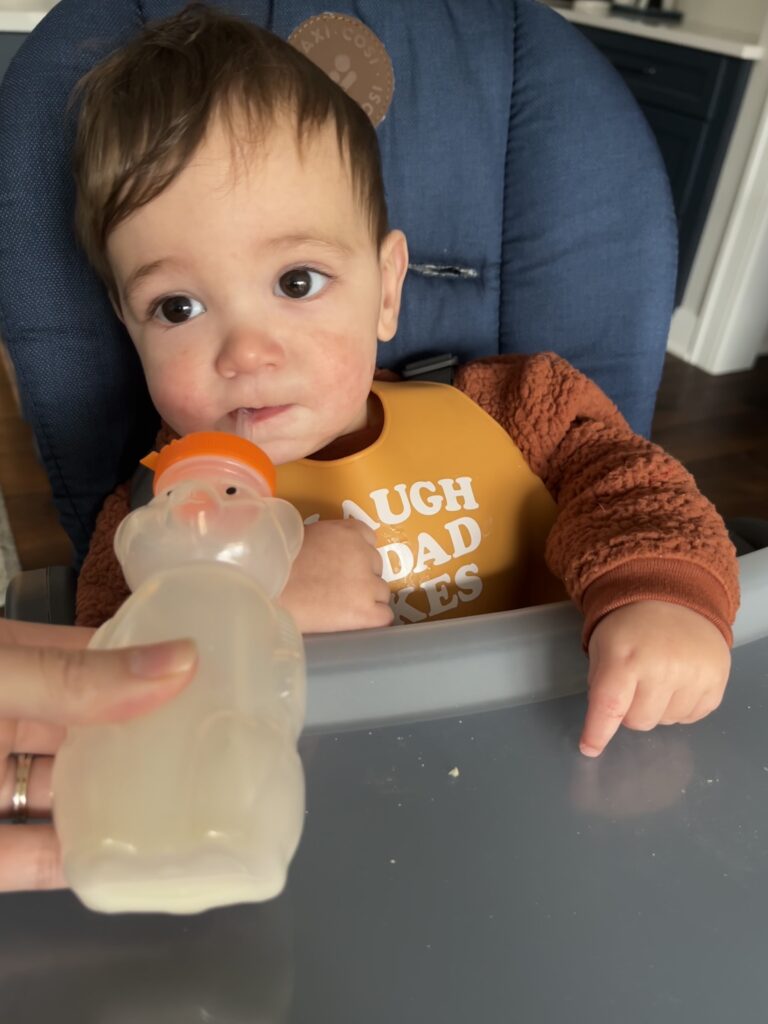
If they’re like most babies this age, your 9-month-old is keeping you busy, busy, busy! It can be tiring to keep them entertained for hours on end on top of other responsibilities. This guide will take the guesswork out of your baby’s playtime, providing activities and exercises that will engage your 9-month-old and further their development.
Activities and Exercises for 9-Month-Old
While many of the activities mentioned in previous guides will still be relevant to your baby, below are some new play ideas you can implement with your little one this month.
Unsupported Sitting
At 9 months old, your baby probably plays most frequently in a sitting position. There are many activities they can do from this position that will help build their core strength, such as the following:

- Playing with shape-sorter toys. A shape-sorter toy usually consists of a box with holes on each side corresponding to a particularly shaped toy. This one also features weaved elastic on one side, which your baby will enjoy playing with when they aren’t matching shapes.
- Other interactive toys, such as ball drops, cause-and-effect toys, and ring stackers, can grab and retain your infant’s attention for several minutes at a time, keeping them seated without much effort on your part. Your baby will also learn useful developmental lessons, such as hand-eye coordination and color recognition.
- Playing Peek-a-boo will continue to help your baby practice sitting while having fun. All you need is a light blanket or scarf to place over your baby’s head (or your own) to simulate “hiding.”
Grasping
Most any 9-month-old baby will be honing their pincer grasp to pick up items between their thumb and forefinger. If you haven’t seen this skill emerge yet, the below activities can help you encourage this grasp and strengthen necessary muscles.
- Pulling and squeezing activities, such as playing with this tissue box toy, can help your child work on their grasp. Pulling the crinkly scarves out of the box will both strengthen their hand muscles and delight their senses.
- Small “finger foods” can also encourage a pincer grasp. Place cheerios, puffs, or cut-up berries directly on a flat surface—not a bowl—and watch as your baby learns to use their finger and thumb to pick up each morsel. If the berries are too slippery, you can coat them in the crumbs of graham crackers or cheerios. Placing food on a flat surface makes it easier for them to grasp.
Crawling

Regardless of whether your baby is crawling, here are some fun activities that will help challenge their mobility. Playing these games might provide that push your baby needs to start crawling or to crawl more often.
- Chase: One of Jack’s favorite games is chasing someone or being chased. It is an especially interactive game, and he always ends up laughing. Babies learn best through imitation, so watching someone else crawl may be just what they need to finally learn the skill!
- Tunnels are a great catalyst for crawling. Try placing a toy at one end as an incentive for your baby to crawl to the other side. Or, peek through the other end of the tunnel at your baby and watch them try to catch you.
High Kneeling

High kneeling is a great play position for this age, challenging your baby’s core strength and balance abilities. That’s why kneeling is such an important stepping stone for mobility. Once mastered, kneeling leads to half-kneeling, which leads to independent standing and finally walking.
- A toy box, at the right height, can invite your baby to assume a kneeling position in order to rummage through their toys. Placing toys on cushions or shelves can also encourage this play position.
- Playing keep-away is another way to get your child up on their knees. Simply hold a toy or, like in the picture, a scarf just above your child’s reach. As they reach for the item, your baby may automatically get into a kneeling position, challenging their core and sense of balance. Jack has so much fun playing keep-away with the scarf!
Sensory Play
Sensory play is any activity that helps your baby explore their 5 main senses: auditory, tactile, visual, taste, and olfactory. Below are some play ideas that will help your baby explore these senses.

- Water play: Bath time is a perfect time for some sensory play, as mentioned in previous guides. Depending on the weather where you live, a shallow pool is perfect for this, too! Getting your baby involved in swim lessons can be fun for both you and your baby. Check out your local swim schools or YMCA for class offerings. *With all water play, be sure to supervise your baby at all times.*
- Noise-making toys: If your baby is anything like little Jack, they love to make noise! Jack recently got his first musical instrument set from Lovevery. He loves playing with the accordion. It is designed for slightly older kids, so he is still a bit too young to know how to move his hands, but he still enjoys hearing the music that comes out of it!
- Suction toys like Squigz can help your child explore their tactile/proprioceptive senses. Pulling off these suction toys and sticking them back on various surfaces will challenge your baby’s hand strength as well as provide a fun cause-and-effect outcome. These Squigz from Amazon feature a variety of textures to tantalize your baby’s tactile sense.
- Playing music or singing to your baby will always be good ways to activate their auditory sense. Try teaching your baby “patty cake” and other interactive songs that will help engage them as they listen.
Supervised Eating/Drinking
Food can both motivate and fascinate your baby as they learn to develop skills necessary for mealtimes. Below are some ways you can help make food more fun:

- Serve what you’re eating: At 9 months old, your baby can eat most anything you eat, so long as it’s baby appropriate. Eating the same food gives them a chance to imitate you and can lead to a more diverse palate as they age.
- Make it easy to eat: Soft foods like cooked vegetables and pasta, juicy fruits, and tender meat are easier for your baby to eat than something hard or crunchy. Small foods are conducive to a pincer grasp, but you can also serve food in long strips so that your baby can hold it in their fist and bite from the top down.
- Don’t give up: Keep trying new foods with your baby, even ones they seemed not to like the first time around. But don’t sweat it; if you don’t feel comfortable feeding your baby your food, feel free to stick to traditional baby food for a bit longer!
- Using a straw should be getting easier now for your baby, but this leakproof honey bear cup is a great starting point if they haven’t yet learned. It allows you to squeeze the cup so the liquid moves up the straw and into your baby’s mouth. Eventually they will learn to suck on the straw to drink. Best practice is to give formula or breastmilk until your baby turns 1, but your doctor may okay water sooner.
- Teething pain is no stranger to 9-month-olds. As mentioned in the previous guides, if your baby is experiencing pain from teething, you can try giving them a frozen breastmilk popsicle, frozen fruit in a fresh food feeder, or a cold water teether.
Reading Books
Continue reading with your baby to help them develop their language skills. There are a few things you can do while reading to help keep your baby interested:
- Identify the items in the pictures that your baby would know (hat, baby, animals, truck, etc.). Point to each one and repeat its name, sticking to a few key words per page so it’s not overwhelming.
- Pointing out those items in real life can help your baby make connections between the “dog” they see in the book and the dog lounging on the living room rug. Before long, they will do this on their own as you go about town and encounter items they recognize from reading.
- Find quality books, like the ones from Lovevery. Designed for babies your age, each book contains a condensed but focused vocabulary to depict a set of concepts, such as emotions, body parts, nature, and more. They even have books that include sign language for everyday words, including “more,” “eat,” and “milk.”
Standing and Dancing

One of the best ways to help your baby develop their strength, motor control, and body awareness is to stand up and dance with them! If they aren’t steady on their feet yet, be mindful of your baby’s surroundings and provide some standing support with the following ideas.
- Encourage standing: If your 9-month-old is pulling up to stand (or close to it), set up your play space to encourage this skill. Placing toys at standing height will incentivize your baby to stand so they can retrieve the toy or play with it. You can also roll a ball back and forth across the coffee table or chaise lounge. Your baby will want to stand up to track the action!
- Play the “bongos”: Another very simple but fun idea is to pretend you’re playing the drums on a surface that’s standing height for your baby. They will love the rhythm and want to stand at attention to watch and interact with your drumming hands. Jack loves this activity and has turned it into a game to try to hit my hands!
Conclusion
Don’t overthink these playtime ideas; sometimes the simplest activities will keep your little one entertained the longest! What’s most important is that they have safe, fun, and interactive playtime that helps them grow stronger and smarter every day. With the help of some simple props, baby-safe toys, snacks, and smiles, it doesn’t take much to help your baby grow in the right direction!

